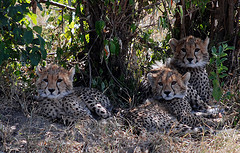|
Baby cheetah
Photo credit / Chadica
When the mother is hunting, she leaves the cheetah cobs hidden, but by 16 days old they are able to follow her. They are suckled for 2 to 3 months but become carnivore as early as 3 weeks.
Cheetah cubs are dark underneath and light on top, with a long, silver-grey mantle of hair running down their necks and backs which help them to camouflage them in grass. By 4 months they are a tawny yellow and almost completely spotted; the tail has bands of black and by adulthood a white tip. Female cheetahs typically have a litter of three cubs and live with them for 18 months. During this time, they raise cubs on their own and procect them as much as they can. Cheetahs have weak jaws and small teeth and are unable to defend their youngs against lions, hyenas, birds of prey. They teach them how to hunt wild prey and then avoid other predators. One day, when their mother judges the time right, she will leave them, often while they are sleeping. The cubs will form a sibling group, which can stay together for up to 6 months. Then, male cheetahs live alone or in small groups, often with their littermates while the female siblings leave to establish their own home ranges. Coalitions of 2 to 5 brothers, and sometimes unrelated males, are formed to better acquire and defend territories.
From Baby cheetah to cheetah facts
|





